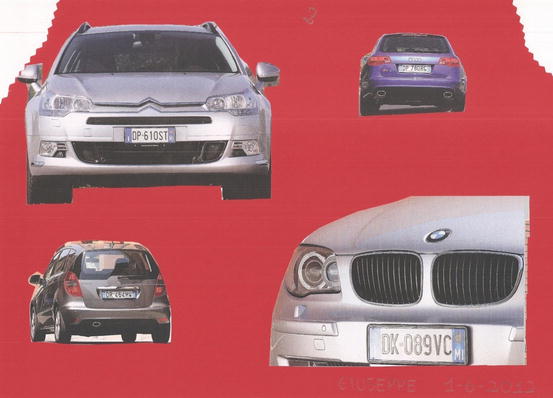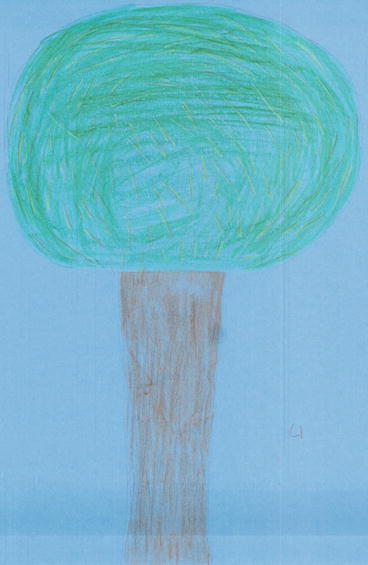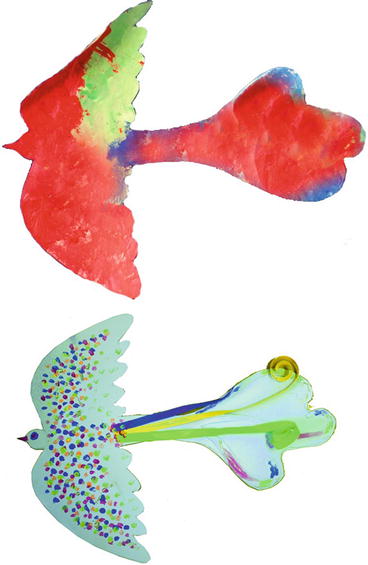Fig. 11.1
Giuseppe’s first Collage

Fig. 11.2
Giuseppe’s second Collage
The next day, he adheres to the proposal to “construct the heart”: the attitude of shyness persists; he speaks only if he is asked some questions but he still proceeds with the activity. He slowly begins to tell us about his creation and he finally manages to confide that it is an especially difficult hospital stay for him and that he cannot wait to go home.
In particular, he says he is struggling, mainly because of the lack of friends and classmates and because he is afraid. After about a week of hospitalization, it is proposed to Giuseppe to draw a tree in an individual session in his room. During this activity, he relates his experience of a previous hospitalization occurred in a hospital in Potenza, in which he only remembers an unpleasant environment and a place full of older people. When he finishes the drawing, he observes it and says that it seems to be made by a 5-year-old child; he believes it is an ugly drawing: the therapists reassure him on the subjectivity of the beautiful and the ugly and remind him that there is no assessment with respect to how beautiful his drawing is (Fig. 11.3).


Fig. 11.3
Giuseppe’s Tree Test
After a couple of days, he is eager to participate to the laboratory, and a stronger and more active membership emerges. After 12 days of hospitalization, it is communicated to the family that the boy will have to undergo surgery, and the mother is very worried because she thinks that the child will not be able to have a normal life like that of his companions. This news takes its toll also on Giuseppe, and the psychologists help him to prepare to the intervention, by accompanying him do a preliminary round of the ICU in order to enable him to become familiar with this environment and especially to emphasize the characteristics that he finds interesting – nice and welcoming staff and a place that “looks like a spaceship.” The intervention has a good outcome and Giuseppe is back in the department after a few days.
During the postoperative phase, the boy complains about physical pain and difficulty in relating to parents, whom he finds overbearing. He tells us his fantasies and his plans for the future: he would like to finish high school and then stop and rest for a few years, to later embark on a submarine on which he would sail “away from everyone.”
From this fantasy, he develops a story, which he entitles “The submarine which lived twice,” which he would like to be read to the art therapy team.
The next time he participates to the laboratory, he arrives accompanied by his parents and he is smiling; he already knows what activities he would like to participate to.
Giuseppe’s course ends on a positive note in his participation to an activity including cardboards proposed by the artist of the department (Fig. 11.4): the choice of colors and the progressive increase in adherence to the activities and enthusiasm lead one to think that the boy has now learned to express his emotions more freely.


Fig. 11.4
Giuseppe’s Cardboard Birds
Giuseppe is discharged the following day: he returns after a month for a checkup and everything progresses well; although he still feels a bit weak, he seems more calm. His case is a clear example of how art therapy can have a positive influence, as it allowed him to socialize with others, to share with them what he feels, and also to deal with the hospitalization and intervention with an increased awareness and tranquility.
11.8 Concluding Remarks
Finally, it is good to point out that art therapy can be useful not only for young patients but also for their parents because, through creativity, they can achieve a living and dynamic interaction with the child, overcoming the sense of inactivity and passivity and the sense of anxiety and anger about not being able to have control and power over the well-being of one’s child. Illness and hospitalization are a time of crisis not only for patients but also for the parents, because it is possible that they can often feel worthless, guilty, and hopeless.
For some of the group meetings with the children, the parents were also present, and in those moments, they exchanged opinions with each other and often the mothers spoke with the department psychologist. The psychologist and the art therapist can help the parent achieve a state of higher awareness and show them possible paths through which they can interact with the child in a more supportive manner. When parents and medical staff, especially the nurses, are adequately prepared for art therapy, the child is able to perceive painful procedures he must undergo as being less traumatic [2].
Each time children are given the opportunity to express themselves, they will learn to be less afraid of their inner world, and they will be more likely to be able to cope with exceptional events and fearful emotions. Usually they do not aim to produce something like a preestablished result: what is important is the activity in itself. Children and adolescents use drawing and artistic expression, regardless of their specific content, to reclaim what has happened to them and to become familiar with the disease and with their fears. The experience of being able to have control over their feelings and sensations, even if on a sheet of drawing paper, is very important given that they cannot control their medical condition.
Stay updated, free articles. Join our Telegram channel

Full access? Get Clinical Tree



